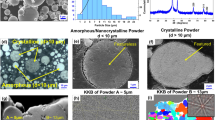Abstract
The work presents the calculations of enthalpy of formation as well as Gibbs energy of reduction of silicon dioxide by aluminum. This way, the possibility of producing Al–Si alloys using amorphous silica fume has been established. The influence of alloying additives and impurities on the silicon reduction process has been determined. The possibility of using magnesium as a surface-active additive, which allows for the removal of oxygen from the surface of dispersed particles and the reduction of silicon, has been demonstrated. Effective methods for producing hypoeutectic and hypereutectic Al–Si alloys using amorphous silica fume have been developed. Alloys with a silicon content exceeding 6 wt% were obtained by blowing preheated (t = 300 °C) amorphous silica fume into the aluminum melt (t = 900 °C) along with the stream of argon followed by intense mixing. Alloys with a silicon content exceeding 16 wt% were manufactured by induction melting of a silicon-containing mixture (60% SiO2, 40% Al + 20% 3NaF·2AlF3) subjected to the presintering (t = 800 °C) when the amorphous silica fume was reduced to crystalline silicon. It has been established that crystalline silicon, which is formed during the roasting of the tableted burden (as a result of reactions in solid phases), is smoothly absorbed by the aluminum melt. Aluminum oxide, obtained during the redox reaction, dissolves in cryolite, after which aluminum and silicon are fused together and transferred to the melt. Industrial implementation of the proposed methods will result in the improved efficiency of the existing process of manufacturing Al–Si alloys, as the energy-intensive stage of the crystalline silicon production is partially excluded, as well as reduce adverse environmental impact.









Similar content being viewed by others
References
P.B. Kuz’min, M.Y.O Kuz’mina, Proizvodstve chushek pervichnykh siluminov, modifitsirovannykh strontsiem. Liteinoe proizvodstvo 8, 2–5 (2014)
Z. Zheng, Y. Ji, W. Mao, Y.U.E. Rui, Z. Liu, Influence of rheo-diecasting processing parameters on microstructure and mechanical properties of hypereutectic Al–30% Si alloy. Trans. Nonferrous Met. Soc. China 27, 1264–1272 (2017)
A.H. Steent, A. Hellawell, Structure and properties of aluminum-silicon eutectic alloys. Acta Metall. 20, 363–370 (1972)
S. Pietrowski, Characteristic features of silumin alloys crystallization. Mater. Des. 18(4–6), 373–383 (1997)
B. Jiang, Z. Ji, M. Hu, H. Xu, S. Xu, A novel modifier on eutectic Si and mechanical properties of Al-Si alloy. Mater. Lett. 239, 13–16 (2019)
N.A. Belov, S.V. Savchenko, A.V. Hvan, Phase composition and structure of silumins: monograph, (Izd. Dom MISiS, Moscow, 2008) 282 p
N.A. Belov, Phase composition of aluminum alloys: monograph, (Izd. Dom MISiS, Moscow, 2009) 398 p
K.M. Sree Manu, K. Sreeraj, T.P.D. Rajan, R.M. Shereema, B.C. Pai, B. Arun, Structure and properties of modified compocast microsilica reinforced aluminum matrix composite. Mater. Des. 88, 294–301 (2015)
W. Cao, S.-L. Chen, F. Zhang, K. Wu, Y. Yang, Y.A. Chang, R. Schmid-Fetzer, W.A. Oates, PANDAT software with PanEngine, PanOptimizer and PanPrecipitation for multi-component phase diagram calculation and materials property simulation. Caplhad 33(2), 323–342 (2009)
H. Bakker, Enthalpies in alloys. Miedema’s semi-empirical model, (Trans Tech Publications. Ltd., Switzerland, 1998) 195 p
M.P. Kuz’min, A.I. Begunov, Priblizhjonnye raschjoty termodinamicheskih harakteristik intermetallicheskih soedinenij na osnove aljuminija. Vestnik IrGTU 1(72), 98–102 (2013)
J.H. Li, T.H. Ludwig, B. Oberdorfer, P. Schumacher, Solidification behaviour of Al–Si based alloys with controlled additions of Eu and P. Int. J. Cast Met. Res. 31(6), 319–331 (2018)
M.P. Kuz’min, V.V. Kondrat’ev, L.M. Larionov, M.Y. Kuz’mina, N.N. Ivanchik, Possibility of preparing alloys of the Al–Si system using amorphous microsilica. Metallurgist 61, 86–91 (2017)
B.C. Pai, G. Ramani, R.M. Pillai, K.G. Satyanarayana, Role of magnesium in cast aluminum alloy matrix composites. J. Mater. Sci. 30, 1903–1911 (1995)
M.C. Gowri Shankar, P.K. Jayashree, Achutha U. Kini, S.S. Sharma, Effect of silicon oxide (SiO2) reinforced particles on ageing behavior of Al-2024 Alloy. Int. J. Mech. Eng. Technol. 5(9), 15–21 (2014)
A.R. Robie, B.S. Hemingway, Thermodynamic properties of minerals and related substances at 298,15 K and 1 bar (105 pascals) pressure and at higher temperatures, (United States Government Printing Office, Washington, 1995) 461 p
R. Ailer, Khimiya kremnezema (Mir, Moscow, 1982), p. 416
J.H. Jeon, J.H. Shin, D.H. Bae, Si phase modification on the elevated temperature mechanical properties of Al–Si hypereutectic alloys. Mater. Sci. Eng. A 748, 367–370 (2019)
S. Hu et al., Effect of a magnetic field on macro segregation of the primary silicon phase in hypereutectic Al–Si alloy during directional solidification. J. Alloy. Compd. 722, 108–115 (2017)
L. Chong, S. Wu, S. Lü, J. Zeng, A. Ping, Dry sliding wear behavior of rheocast hypereutectic Al–Si alloys with different Fe contents. Trans. Nonferrous Met. Soc. China 26, 665–675 (2016)
H.K. Feng, S.R. Yu, Y.L. Li, L.Y. Gong, Effect of ultrasonic treatment on microstructures of hypereutectic Al–Si alloy. J. Mater. Process. Technol. 208, 330–350 (2008)
S.G. Shabestari, E. Parshizfard, Effect of semi-solid forming on the microstructure and mechanical properties of the iron containing Al−Si alloys. J. Alloys Compd. 509, 7973–7978 (2011)
W.L. Chong, G.S. Zhong, W. Li, A. Ping, Effect of ultrasonic vibration on Fe-containing intermetallic compounds of hypereutectic Al−Si alloys with high Fe content. Trans. Nonferrous Met. Soc. China 23(5), 1245–1252 (2013)
Author information
Authors and Affiliations
Corresponding author
Additional information
Publisher's Note
Springer Nature remains neutral with regard to jurisdictional claims in published maps and institutional affiliations.
Rights and permissions
About this article
Cite this article
Kuz’min, M.P., Larionov, L.M., Chu, P.K. et al. New Methods of Obtaining Al–Si Alloys Using Amorphous Microsilica. Inter Metalcast 14, 207–217 (2020). https://doi.org/10.1007/s40962-019-00353-w
Published:
Issue Date:
DOI: https://doi.org/10.1007/s40962-019-00353-w




